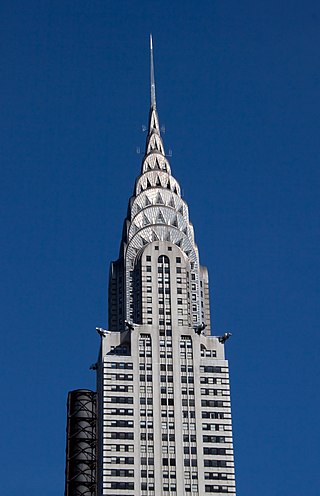
Art Deco, short for the French Arts Décoratifs, and sometimes referred to simply as Deco, is a style of visual arts, architecture, and product design, that first appeared in France in the 1910s, and flourished in the United States and Europe during the 1920s to early 1930s. Through styling and design of the exterior and interior of anything from large structures to small objects, including how people look, Art Deco has influenced bridges, buildings, ships, ocean liners, trains, cars, trucks, buses, furniture, and everyday objects like radios and vacuum cleaners.

Gelderland, also known as Guelders in English, is a province of the Netherlands, occupying the centre-east of the country. With a total area of 5,136 km2 (1,983 sq mi) of which 173 km2 (67 sq mi) is water, it is the largest province of the Netherlands by land area, and second by total area. Gelderland shares borders with six other provinces and the German state of North Rhine-Westphalia.

Art Nouveau is an international style of art, architecture, and applied art, especially the decorative arts. It was often inspired by natural forms such as the sinuous curves of plants and flowers. Other characteristics of Art Nouveau were a sense of dynamism and movement, often given by asymmetry or whiplash lines, and the use of modern materials, particularly iron, glass, ceramics and later concrete, to create unusual forms and larger open spaces. It was popular between 1890 and 1910 during the Belle Époque period, and was a reaction against the academicism, eclecticism and historicism of 19th century architecture and decorative art.
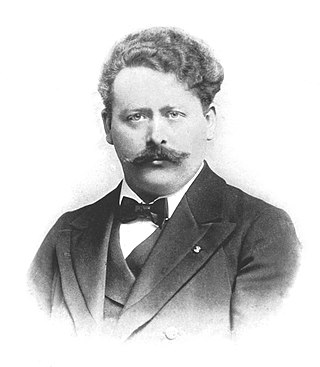
Joseph Wilhelm Mengelberg was a Dutch conductor, famous for his performances of Beethoven, Brahms, Mahler and Strauss with the Concertgebouw Orchestra in Amsterdam. He is widely regarded as one of the greatest symphonic conductors of the 20th century.
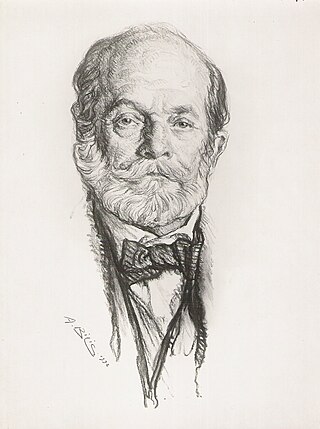
Auguste Perret was a French architect and a pioneer of the architectural use of reinforced concrete. His major works include the Théâtre des Champs-Élysées, the first Art Deco building in Paris; the Church of Notre-Dame du Raincy (1922–23); the Mobilier National in Paris (1937); and the French Economic, Social and Environmental Council building in Paris (1937–39). After World War II he designed a group of buildings in the centre of the port city of Le Havre, including St. Joseph's Church, Le Havre, to replace buildings destroyed by bombing during World War II. His reconstruction of the city is now a World Heritage Site for its exceptional urban planning and architecture.

Victor Pierre Horta was a Belgian architect and designer, and one of the founders of the Art Nouveau movement. He was a fervent admirer of the French architectural theorist Eugène Viollet-le-Duc and his Hôtel Tassel in Brussels (1892–93), often considered the first Art Nouveau house, is based on the work of Viollet-le-Duc. The curving stylized vegetal forms that Horta used in turn influenced many others, including the French architect Hector Guimard, who used it in the first Art Nouveau apartment building he designed in Paris and in the entrances he designed for the Paris Metro. He is also considered a precursor of modern architecture for his open floor plans and his innovative use of iron, steel and glass.

Severance Hall, also known as Severance Music Center, is a concert hall in the University Circle neighborhood of Cleveland, Ohio, home to the Cleveland Orchestra. Opened in 1931 to give the orchestra a permanent home, the building is named for patrons John L. Severance and his wife, Elisabeth Huntingdon DeWitt Severance. It is listed on the National Register of Historic Places as part of Cleveland’s Wade Park District.

Forest or Vorst, is one of the 19 municipalities of the Brussels-Capital Region, Belgium. Located in the southern part of the region, it is bordered by Anderlecht, Ixelles, Uccle, and Saint-Gilles, as well as the Flemish municipality of Drogenbos. In common with all of Brussels' municipalities, it is legally bilingual (French–Dutch).

A festoon is a wreath or garland hanging from two points, and in architecture typically a carved ornament depicting conventional arrangement of flowers, foliage or fruit bound together and suspended by ribbons. The motif is sometimes known as a swag when depicting fabric or linen.

The International Exhibition of Modern Decorative and Industrial Arts was a specialized exhibition held in Paris, France, from April to October 1925. It was designed by the French government to highlight the new modern style of architecture, interior decoration, furniture, glass, jewelry and other decorative arts in Europe and throughout the world. Many ideas of the international avant-garde in the fields of architecture and applied arts were presented for the first time at the exposition. The event took place between the esplanade of Les Invalides and the entrances of the Grand Palais and Petit Palais, and on both banks of the Seine. There were 15,000 exhibitors from twenty different countries, and it was visited by sixteen million people during its seven-month run. The modern style presented at the exposition later became known as "Art Deco", after the exposition's name.

The Centre for Fine Arts is a multi-purpose cultural venue in central Brussels, Belgium. It is often referred to as BOZAR in French or PSK in Dutch. The building was designed by the architect Victor Horta, and completed in 1929 at the instigation of the banker and patron of the arts Henry Le Bœuf. It includes exhibition and conference rooms, a cinema and a concert hall, which serves as home to the Belgian National Orchestra.

The Conservatorium van Amsterdam (CvA) is a Dutch conservatoire of music located in Amsterdam. This school is the music division of the Amsterdam University of the Arts, the city's vocational university of arts. The Conservatorium van Amsterdam is the largest music academy in the Netherlands, offering programs in classical music, jazz, pop, electronic music, early music, music education, and opera.

A cartouche is an oval or oblong design with a slightly convex surface, typically edged with ornamental scrollwork. It is used to hold a painted or low-relief design. Since the early 16th century, the cartouche is a scrolling frame device, derived originally from Italian cartuccia. Such cartouches are characteristically stretched, pierced and scrolling.

In architecture and the decorative arts, a mascaron ornament is a face, usually human, sometimes frightening or chimeric, whose alleged function was originally to frighten away evil spirits so that they would not enter the building. The concept was subsequently adapted to become a purely decorative element. The most recent architectural styles to extensively employ mascarons were Beaux Arts and Art Nouveau. In addition to architecture, mascarons are used in the other applied arts.

Guila Bustabo was a prominent American concert and recital violinist.

Music venues in the Netherlands are a vivid part of the social cultural environment of the country.
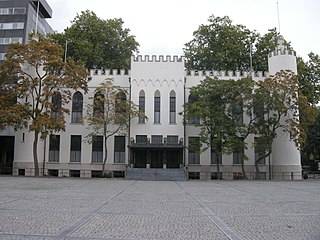
The City Hall of Tilburg or Palace-Council House is a former royal palace and presently a part of Tilburg city hall in the Netherlands. Construction of the palace was commissioned by King William II of the Netherlands, who placed the cornerstone on 13 August 1847. The king wanted to have a country residence in Tilburg. He never lived in the palace as he died on 17 March 1849, just 22 days before completion of the palace.
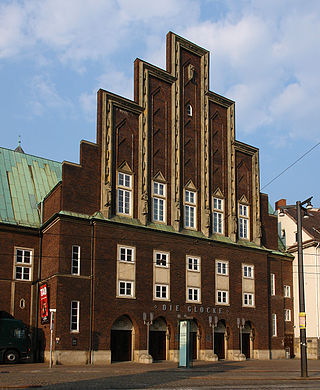
Die Glocke is a concert hall in the centre of Bremen, Germany. Standing on the site of a building from the Middle Ages, it was designed by Walter Görig (1885–1974) and completed in 1928. Its elegant Art Deco design and excellent acoustics have been praised by a number of artists including Herbert von Karajan.

La Maison Cubiste, also called Projet d'hôtel, was an architectural installation in the Art Décoratif section of the 1912 Paris Salon d'Automne which presented a Cubist vision of architecture and design. Critics and collectors present at the exhibition were confronted for the first time with the prospect of a Cubist architecture.
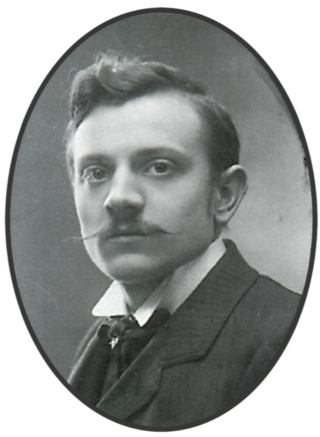
Geo (Georges) Verbanck was a Belgian sculptor and medalist.



























